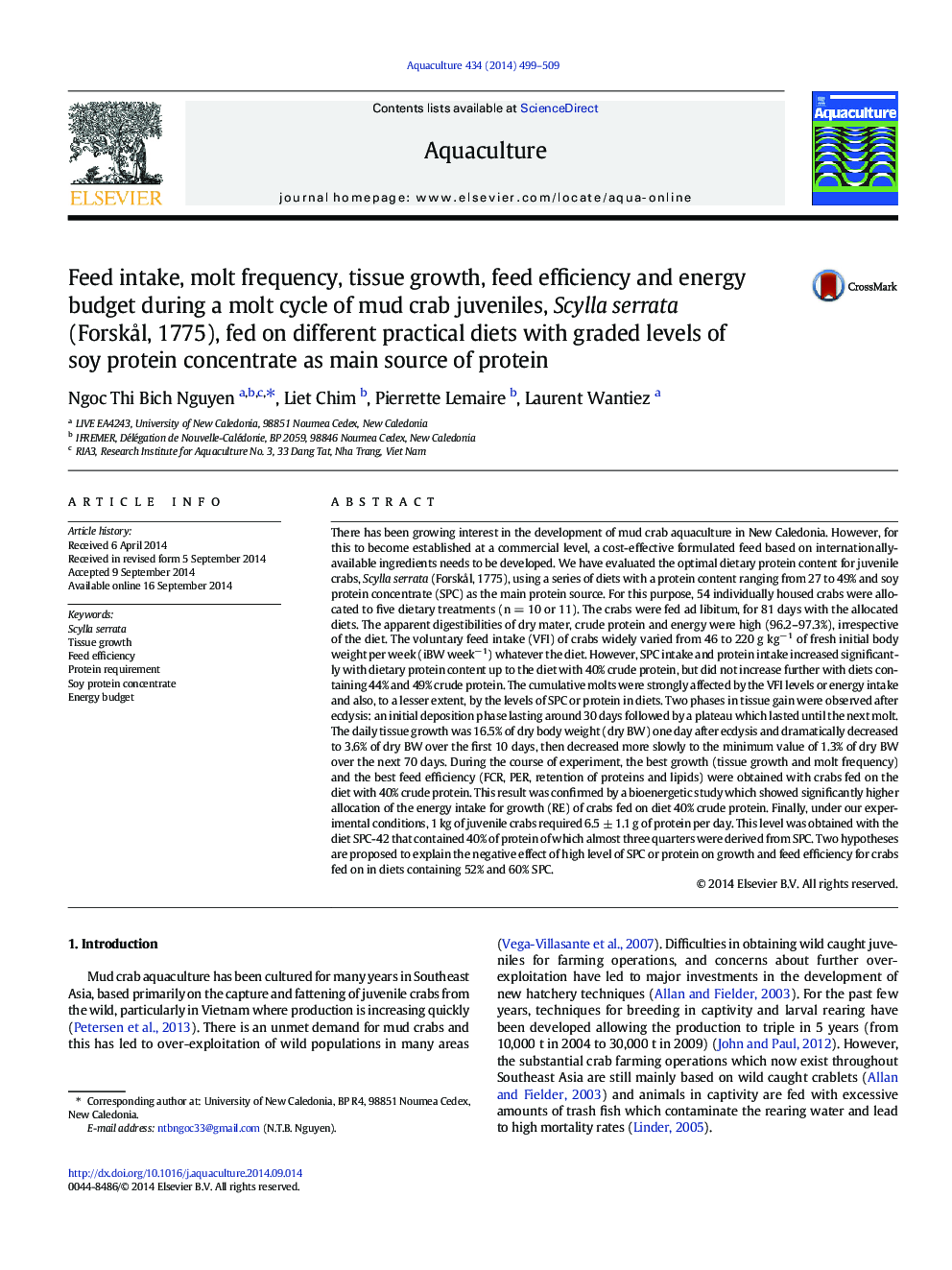| کد مقاله | کد نشریه | سال انتشار | مقاله انگلیسی | نسخه تمام متن |
|---|---|---|---|---|
| 2421701 | 1552853 | 2014 | 11 صفحه PDF | دانلود رایگان |

• There were two tissue growth periods of crabs during a molt cycle: FTG (Fast tissue growth) corresponding to postmolt period and STG (Slow tissue growth) corresponding to intermolt & premolt periods.
• Protein, lipid and ash gain during one molt cycle correlated to tissue growth model.
• Voluntary feed intake (VFI) followed the same trend with tissue growth.
• VFI or energy intake had a strong effect on molt frequency or intermolt cycle. Higher VFI level resulted in higher cumulative molts.
• Crabs fed on diet SPC-42 (40% crude protein content in which ¾ from soy protein concentrate-SPC) exhibited the best growth (tissue growth and molt frequency) then leading the highest feed efficiency (FCR, PRE, retention of protein and lipid).
• No effect of different SPC levels in the dietary diets on size increment after molt.
• Highest and lowest energy intake respectively allocated in RE (growth energy), HEm (maintenance energy) were observed for crabs fed on SPC-42.
There has been growing interest in the development of mud crab aquaculture in New Caledonia. However, for this to become established at a commercial level, a cost-effective formulated feed based on internationally-available ingredients needs to be developed. We have evaluated the optimal dietary protein content for juvenile crabs, Scylla serrata (Forskål, 1775), using a series of diets with a protein content ranging from 27 to 49% and soy protein concentrate (SPC) as the main protein source. For this purpose, 54 individually housed crabs were allocated to five dietary treatments (n = 10 or 11). The crabs were fed ad libitum, for 81 days with the allocated diets. The apparent digestibilities of dry mater, crude protein and energy were high (96.2–97.3%), irrespective of the diet. The voluntary feed intake (VFI) of crabs widely varied from 46 to 220 g kg− 1 of fresh initial body weight per week (iBW week− 1) whatever the diet. However, SPC intake and protein intake increased significantly with dietary protein content up to the diet with 40% crude protein, but did not increase further with diets containing 44% and 49% crude protein. The cumulative molts were strongly affected by the VFI levels or energy intake and also, to a lesser extent, by the levels of SPC or protein in diets. Two phases in tissue gain were observed after ecdysis: an initial deposition phase lasting around 30 days followed by a plateau which lasted until the next molt. The daily tissue growth was 16.5% of dry body weight (dry BW) one day after ecdysis and dramatically decreased to 3.6% of dry BW over the first 10 days, then decreased more slowly to the minimum value of 1.3% of dry BW over the next 70 days. During the course of experiment, the best growth (tissue growth and molt frequency) and the best feed efficiency (FCR, PER, retention of proteins and lipids) were obtained with crabs fed on the diet with 40% crude protein. This result was confirmed by a bioenergetic study which showed significantly higher allocation of the energy intake for growth (RE) of crabs fed on diet 40% crude protein. Finally, under our experimental conditions, 1 kg of juvenile crabs required 6.5 ± 1.1 g of protein per day. This level was obtained with the diet SPC-42 that contained 40% of protein of which almost three quarters were derived from SPC. Two hypotheses are proposed to explain the negative effect of high level of SPC or protein on growth and feed efficiency for crabs fed on in diets containing 52% and 60% SPC.
Journal: Aquaculture - Volume 434, 20 October 2014, Pages 499–509